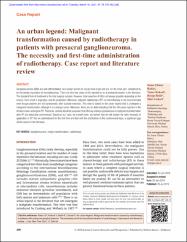An urban legend: Malignant transformation caused by radiotherapy in patients with presacral ganglioneuroma. The necessity and first-time administration of radiotherapy. Case report and literature review
Citation
Rakici, S. Y., Koksal, V., Bedir, R., & Goksel, S. (2021). An urban legend: Malignant transformation caused by radiotherapy in patients with presacral ganglioneuroma. The necessity and first-time administration of radiotherapy. Case report and literature review. Journal of cancer research and therapeutics, 17(1), 248–254. https://doi.org/10.4103/jcrt.JCRT_380_18Abstract
Ganglioneuromas (GNs) are well-differentiated, rare benign tumors of neural crest origin and are, for the most part, considered to be the benign equivalent of neuroblastomas. There are very few cases of GN reported to be at presacral location in the literature. The standard form of treatment is the total surgical excision. However, total resection of GN is not always possible depending on the neuron, from which it originates, and its localization. Moreover, adjuvant radiotherapy (RT) or chemotherapy is not recommended even though patients are still symptomatic after subtotal resection. This view is based on the urban legend that it undergoes a malignant transformation although it is a benign tumor. Moreover, there are no data indicating that the GN cases reported in the literature have undergone RT. Therefore, articles about the suspicion that GN may undergo spontaneous or malignant transformation after RT are absolutely controversial. Based on our case, we present here, we believe that we will explain the valid necessity of application of RT that we administered for the first time and that with the clarification of this controversial topic, a significant gap will be closed in the literature.


















